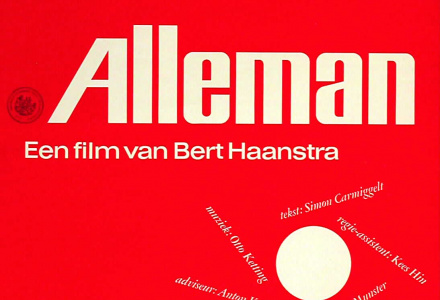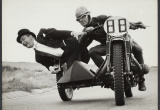The Dutch Documentary in the Cinema: Alleman and the 1960s
In his 1995 book, Hollands Hollywood, Henk van Gelder describes every Dutch feature film that was made up through 1994. It’s a long summary of titles, and Van Gelder’s taken a bit of liberty in compiling it. He’s skipped silent film altogether, for example, and starts instead with the first ‘official’ Dutch sound film, Willem van Oranje, made in 1934. Children’s films, an important genre within Dutch film, are also omitted. On the other hand, he does choose to include a number of documentaries in his list. His criterium for this is that he has mainly looked at whether the films were made for a wide audience and if they had been commercially distributed in the cinemas. This made it possible to include Vrij en onverveerd (G.T. Cummins, 1945), Alleman, Bij de beesten af and Hans, het leven voor de dood in his book.
Although the basis for including these films might seem arbitrary – and Van Gelder would be the first to agree – they certainly have played a role in Dutch film and cinema culture. Particularly in the 1960s, documentaries such as Alleman, De stem van het water, Faja Lobbi and Kees Brusse’s ‘psychomontage’ Mensen van morgen were among the best-viewed films.
The Success of the Dutch Documentary
The Dutch documentary had already caused a stir in the 1950s. In particular, the short documentaries from filmmakers such as Herman van der Horst, Bert Haanstra, Ytzen Brusse and Louis van Gasteren were a hit both at home and abroad. Haanstra and Van der Horst won a Golden Palm at the prestigious Cannes Film Festival, and Haanstra saw to it that Glas (1958) won the very first Oscar for the Netherlands in 1960. The documentaries were also screened in cinemas as part of the supporting programme in the Cineac theatres (these were originally newsreel cinemas; later they also developed longer documentary and children’s film programmes).
Within a few years at the beginning of the 1960s there were a number of long Dutch documentaries that were released as feature films in the cinemas. Starting with Faja Lobbi and followed by Wederzijds – Gerard Rutten’s homage to Queen Wilhelmina – the high point was reached with Haanstra’s Alleman. The latter was an unequalled success with audiences, drawing more than 1.6 million viewers; it was also, however, a film that stirred up some controversy.
Criticism
It was chiefly the young wave of filmmakers associated with the new film magazine Skoop – supported by Jan Blokker of the Algemeen Handelsblad – who were critical of Alleman, Haanstra’s (and Simon Carmiggelt’s) perspective on Dutch society. ‘Corny’ was the mildest critique used. There were other, more venomous comments about Haanstra using a ‘candid camera’ style instead of a more documentary approach.
The critique wasn’t limited to only Haanstra’s film, however. Kees Brusse was also the subject of controversy when his 1964 film Mensen van morgen was released. The film was inspired by Bertrand Bliers’ film Hitler....connais pas (France, 1963).
In the original film, adolescents were asked questions about their problems and expectations. Brusse adopted the idea and interviewed twelve Dutch teenagers. He then edited the footage in a way that gave the impression that the teens were listening and reacting to each other. Nothing was further from the truth, however – Brusse had interviewed them all separately – and this editing trick aroused much protest. And again, Blokker was one of the critics – the film didn’t meet the prevailing laws of cinéma vérité – but he was impressed by Brusse’s sincerity, and praised his integrity.
The truly innovative documentaries were, however, screened on television – Johan van der Keuken gathered a following with his short documentaries made for the VPRO.
more information
If you are looking for more material from our collection, please contact
Ms. Leenke Ripmeester
sales@eyefilm.nl
phone +31 (0)20 5891 426
mobile +31 (0)6 4118 9635

